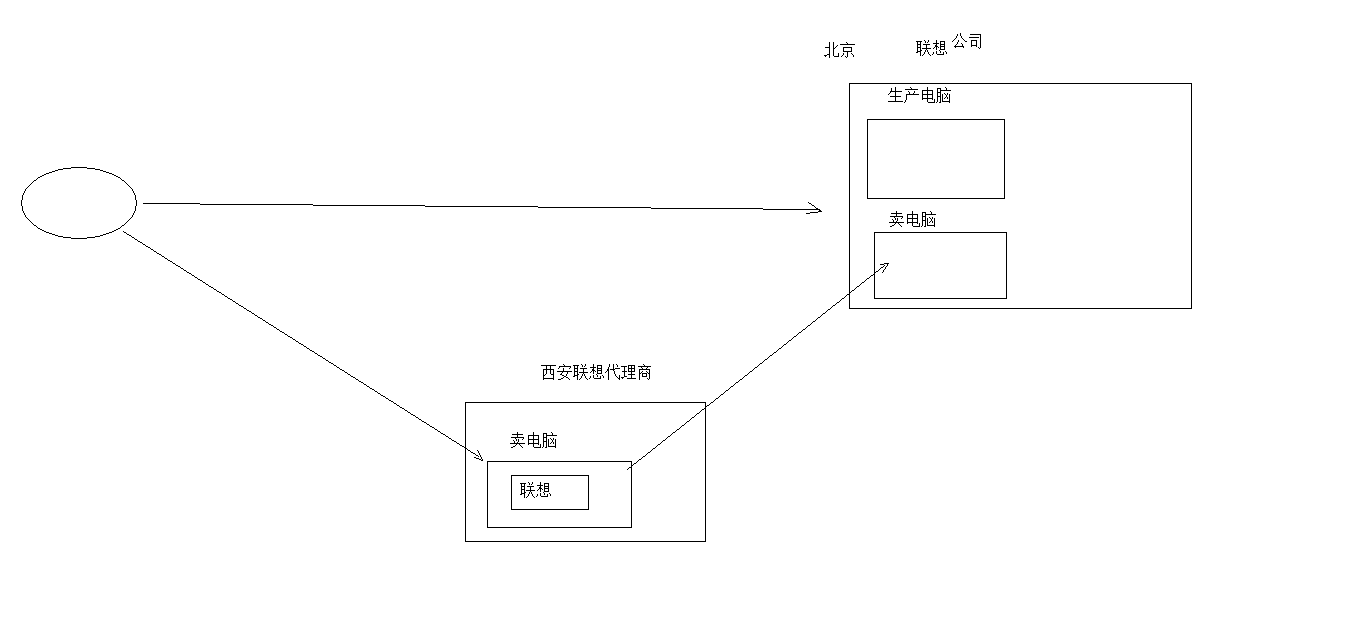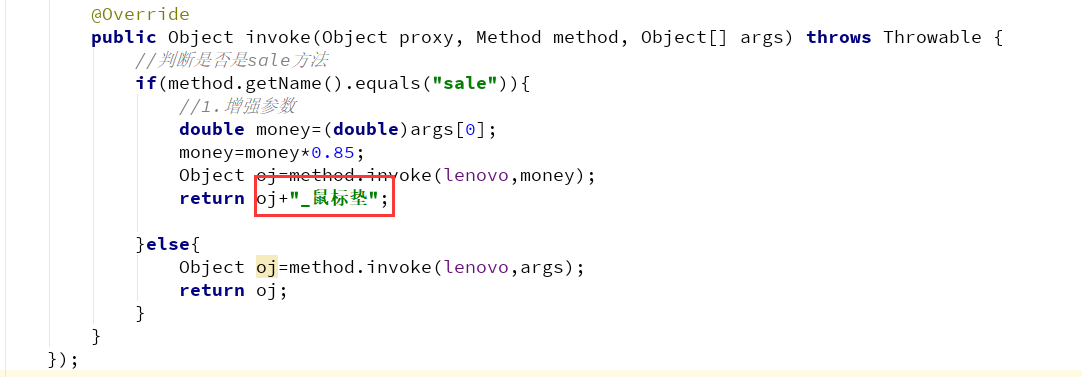代理模式

概念:
- 真实对象:被代理的对象
- 代理对象:
- 代理模式:代理对象代理真实对象,达到增强真实对象功能的目的
实现方式:
静态代理
有一个类文件描述代理模式
动态代理
在内存中形成代理类
实现步骤:
- 代理对象和真实对象实现相同的接口
- 代理对象 =
Proxy.newProxyInstance();
- 使用代理对象调用方法。
- 增强方法
示例:

创建代理接口SaleComputer
1
2
3
4
5
| package com.uestc.proxy;
public interface SaleComputer {
public String sale(double money);
public void show();
}
|
创建真实类Lenovo
1
2
3
4
5
6
7
8
9
10
11
12
13
14
15
| package com.uestc.proxy;
public class Lenovo implements SaleComputer {
@Override
public String sale(double money) {
System.out.println("花了"+money+"买了一台联想电脑");
return "联想电脑";
}
@Override
public void show() {
System.out.println("展示电脑。。");
}
}
|
创建代理测试类ProxyTest
1
2
3
4
5
6
7
8
9
10
11
12
13
14
15
16
17
18
19
20
21
22
23
24
25
26
27
28
29
30
31
32
33
34
35
36
37
38
39
40
41
| package com.uestc.proxy;
import java.lang.reflect.InvocationHandler;
import java.lang.reflect.Method;
import java.lang.reflect.Proxy;
public class ProxyTest {
public static void main(String[] args) {
Lenovo lenovo=new Lenovo();
SaleComputer proxy_lenono=(SaleComputer)Proxy.newProxyInstance(lenovo.getClass().getClassLoader(), lenovo.getClass().getInterfaces(), new InvocationHandler() {
@Override
public Object invoke(Object proxy, Method method, Object[] args) throws Throwable {
System.out.println(method.getName());
System.out.println(args[0]);
return null;
}
});
String compute=proxy_lenono.sale(8000);
System.out.println(compute);
}
}
|
效果展示:

问题:这里代理对象并没有执行真实对象的sale方法,那么我们怎么执行呢?
1
2
3
4
5
6
7
8
9
10
11
12
13
14
15
16
17
18
19
20
21
22
23
24
25
26
27
28
29
30
31
32
33
34
35
36
37
| package com.uestc.proxy;
import java.lang.reflect.InvocationHandler;
import java.lang.reflect.Method;
import java.lang.reflect.Proxy;
public class ProxyTest {
public static void main(String[] args) {
Lenovo lenovo=new Lenovo();
SaleComputer proxy_lenono=(SaleComputer)Proxy.newProxyInstance(lenovo.getClass().getClassLoader(), lenovo.getClass().getInterfaces(), new InvocationHandler() {
@Override
public Object invoke(Object proxy, Method method, Object[] args) throws Throwable {
Object oj=method.invoke(lenovo,args);
return oj;
}
});
String compute=proxy_lenono.sale(8000);
System.out.println(compute);
}
}
|

增强方式:
- 增强参数列表
- 增强返回值类型
- 增强方法体执行逻辑
1. 增强参数列表
代理商折扣money
1
2
3
4
5
6
7
8
9
10
11
12
13
14
15
16
17
18
19
20
21
22
23
24
25
26
27
28
29
30
31
32
33
34
35
36
37
38
39
40
41
42
43
44
45
| package com.uestc.proxy;
import java.lang.reflect.InvocationHandler;
import java.lang.reflect.Method;
import java.lang.reflect.Proxy;
public class ProxyTest {
public static void main(String[] args) {
Lenovo lenovo=new Lenovo();
SaleComputer proxy_lenono=(SaleComputer)Proxy.newProxyInstance(lenovo.getClass().getClassLoader(), lenovo.getClass().getInterfaces(), new InvocationHandler() {
@Override
public Object invoke(Object proxy, Method method, Object[] args) throws Throwable {
if(method.getName().equals("sale")){
double money=(double)args[0];
money=money*0.85;
Object oj=method.invoke(lenovo,money);
return oj;
}else{
Object oj=method.invoke(lenovo,args);
return oj;
}
}
});
String compute=proxy_lenono.sale(8000);
System.out.println(compute);
}
}
|

2. 增强返回值类型
代理商返回给用户电脑加额外的鼠标垫


3. 增强方法体执行逻辑
1
2
3
4
5
6
7
8
9
10
11
12
13
14
15
16
17
18
19
20
21
22
23
24
25
26
27
28
29
30
31
32
33
34
35
36
37
38
39
40
41
42
43
44
45
46
47
48
| package com.uestc.proxy;
import java.lang.reflect.InvocationHandler;
import java.lang.reflect.Method;
import java.lang.reflect.Proxy;
public class ProxyTest {
public static void main(String[] args) {
Lenovo lenovo=new Lenovo();
SaleComputer proxy_lenono=(SaleComputer)Proxy.newProxyInstance(lenovo.getClass().getClassLoader(), lenovo.getClass().getInterfaces(), new InvocationHandler() {
@Override
public Object invoke(Object proxy, Method method, Object[] args) throws Throwable {
if(method.getName().equals("sale")){
double money=(double)args[0];
money=money*0.85;
System.out.println("专车接你。。。");
Object oj=method.invoke(lenovo,money);
System.out.println("免费送货。。。");
return oj+"_鼠标垫";
}else{
Object oj=method.invoke(lenovo,args);
return oj;
}
}
});
String compute=proxy_lenono.sale(8000);
System.out.println(compute);
}
}
|










